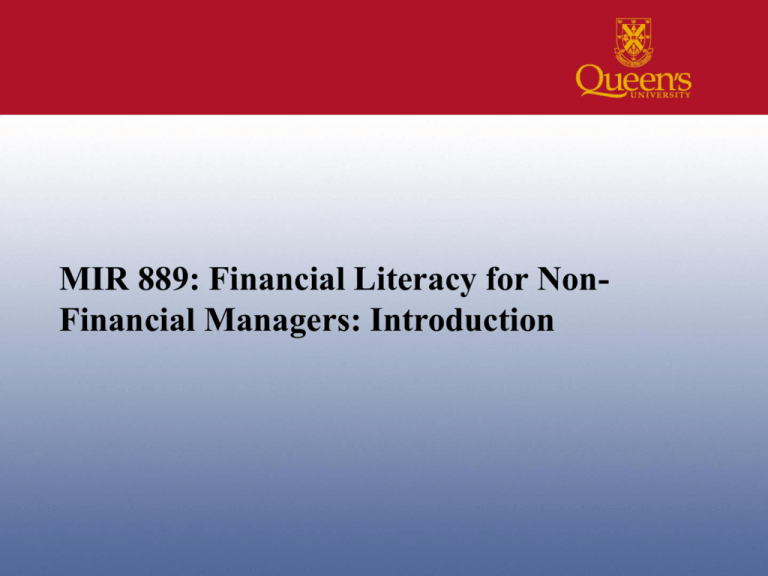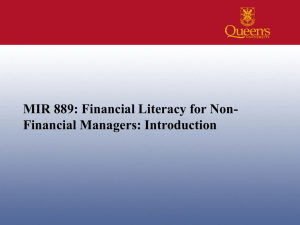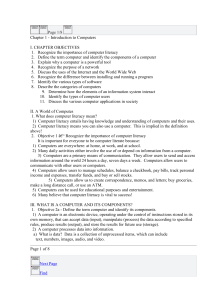MIR 889: Financial Literacy for Non-Financial
advertisement

MIR 889: Financial Literacy for NonFinancial Managers: Introduction Today’s Session • Introductions: Around the room: who are you, your background, your expectations. • Relationship of Accounting to Business Strategy – Len • Financial Literacy: What is that? – Andy • Users of Financial information: what and why – Len and Andy 2 3 Course Objectives • Familiarization with financial concepts • Comfort with discussing the financial aspects of the work • Demystify financial management • Leveraging financial literacy to get your job done. 4 About Us • Len Anderson • Andrew Graham 5 About You Tell us who you are, what your background is, what you aspire to on graduation and your expectations for this course. Please use your Name Cards 6 About the Course: Approach to Learning • Classes will be active. Students will be asked to undertake the following tasks, as part of the learning and evaluation process: – Text reading, – Some assigned out-of-class exercise, – Class case studies for discussion in group and feedback, – Reviews of annual reports and financial statements, – Group work and presentations (2), including a capstone final presentation, and – Written assignments. 7 About the Course: Text and Readings Accounting for Non-financial Manager, Third Edition, John Parkinson with Charles Draimin, Captus Press All other readings will be provided on the Moodle site in pdf format. 8 About the Course: Assignments For the Presentations, a marking rubric has been provided in the Outline. 9 Some behavioral expectations… • • • • You are expected to attend class Computers are fine, but texting is not Working in teams is fine We are happy to sit down with you or a group to discuss a problem • We are happy to provide feedback on assignments individually 10 About the Course: Architecture Shareholder Perspective • Foundations: The World and Language of Accounting Management Perspective • Applications: Budgets, Risk, Control and Performance 11 About the Course: The Flow Accounting Fundamentals Assessing Performance Financial Statements Analysing Financial Statements Risk and Control Business Planning Financial Reporting 12 13 Remember, there is no stupid question. 14 Establishing context Consider the following metaphor: what does it tell us about success in business? Nascar strategy 15 Fundamentally • Business success is about direction and traction • Accounting is a tool to help with direction setting and the measurement of traction 16 17 Business Literacy, not Personal…. • All inputs to achieving direction and traction cost something – examples….. • Choices made based on the quality fo the idea in getting a business outcome in conjunction with costs and expected return. 18 Business Literacy, not Personal…. • No organization has unlimited reserves of cash, credit lines or goodwill – choices have to be made. • There is always competition for resources. • Linking what you do to help the company, what you need to do it and how to get and use the resources is heart of financial literacy. 19 What is Financial Literacy? • Understand the lingo: – Some core terminology is essential. – However, much of this terminology may have nuanced meaning in the particular operating culture of one organization. • Read the Reports: – This is best translated as being an intelligent user of financial information, be it costing for policy design or cash forecasts for the first quarter of the fiscal year. 20 Working with Finance Understanding language of finance Getting Resources Adding value to company You as IR leader Translating IR value into company value 21 What is Financial Literacy? • Get Clarity: – This may mean asking dumb questions. – It may also mean pushing the point of understanding so that everyone is actually talking about the same thing. • Marry up Numbers on a Pages with What Happens at the Mission End of the Organization: – A financially literate manager can see the link – or insist that it be clearly stated – between what may be for some just a bunch of numbers and the policy and operational impact. 22 Not Just a Financially Literate Manager or HR/IR Advisor, but a Financially Literate Organization • All managers do not need to be accountants • Being ready users of financial tools and information is great • If the company does not use these tools it will fail • Two-way street – financial people need to understand what you do 23 Are Finance and HR Oil and Water? Words to describe concerns of Finance and Human Resources 24 So being financially savvy is good for the company Finance Human Resources 25 26 Forecasting Controlling Financial Condition Analysis Costing Identifying, Assessing and Managing Risk Core FM Skills Communicating financial and program information 27 Users and uses • In groups, read the tabletop cases handed out • Take 15 minutes for reading and discussing in your groups • Tabulate the following: • Who are the likely users of the financial statements in each case? • For which of the three purposes do they seek information ? • How do they get the information? 28 Wrap up • Questions? • Homework – read Parkinson Chapters 2, 4 and 5 including appendix 4.1 29






